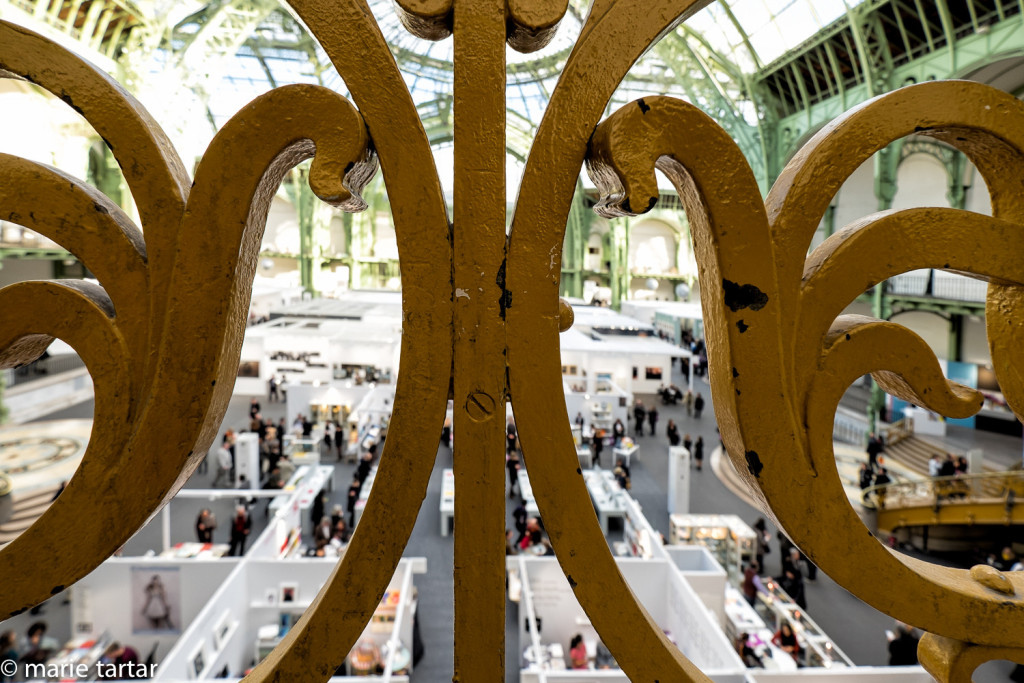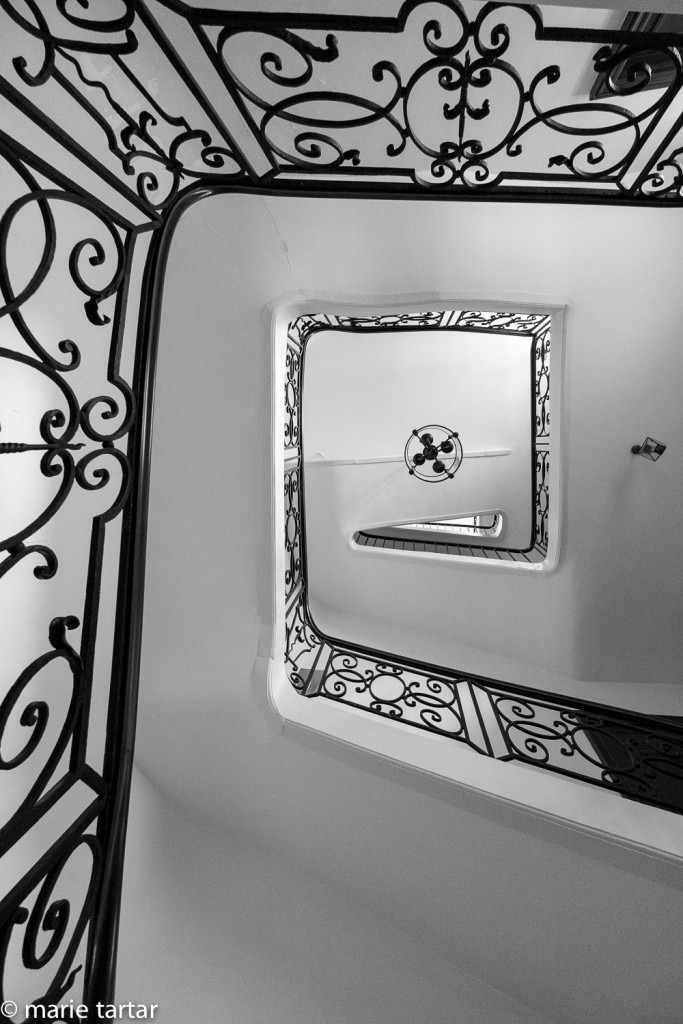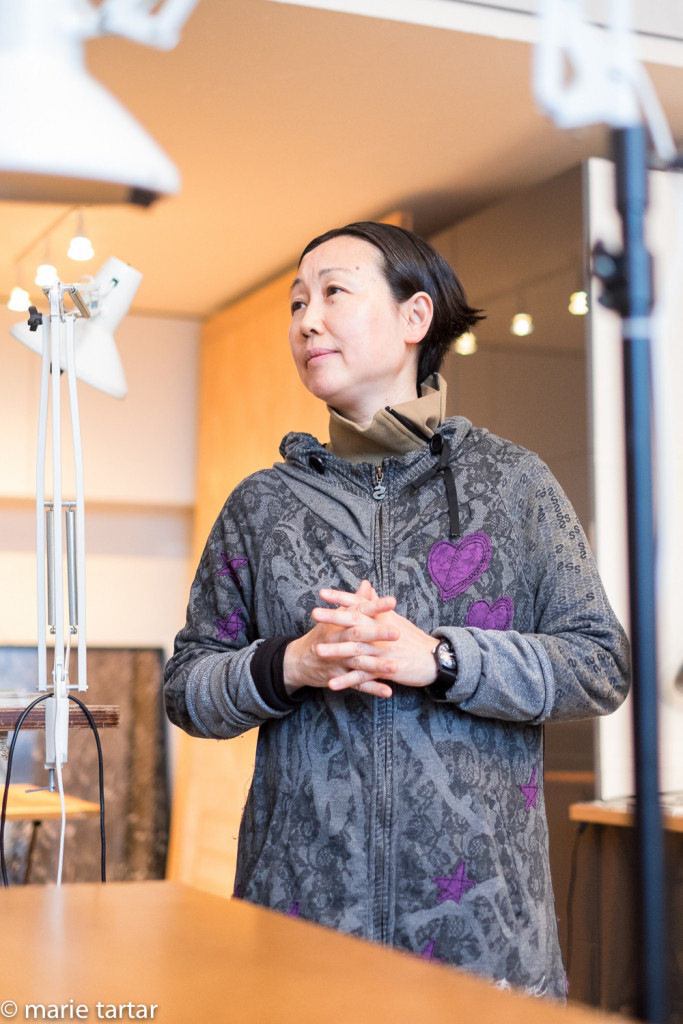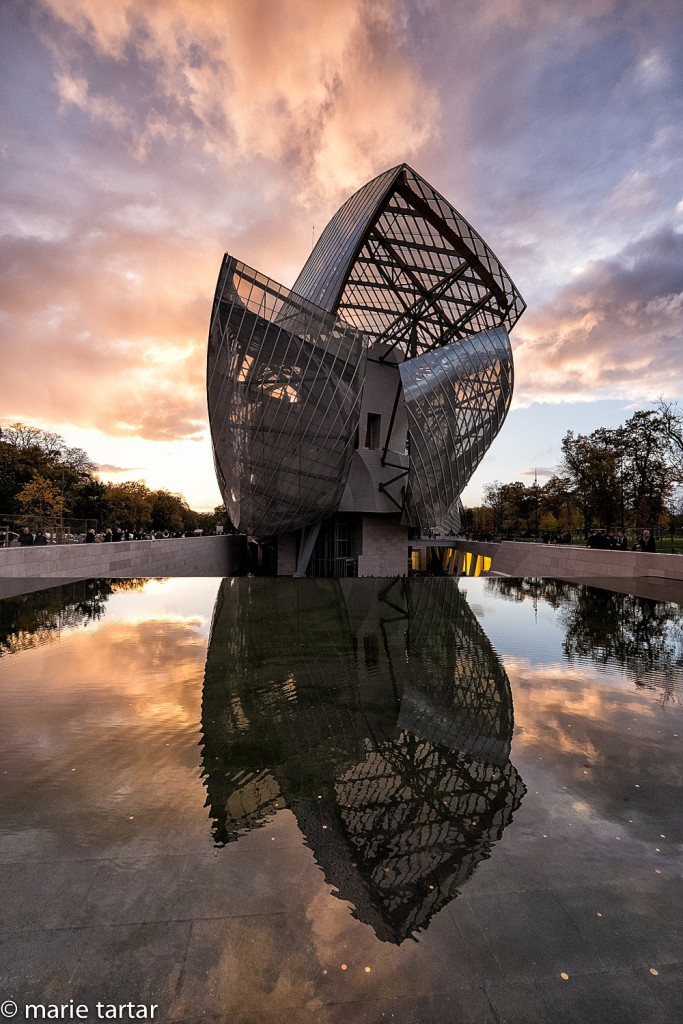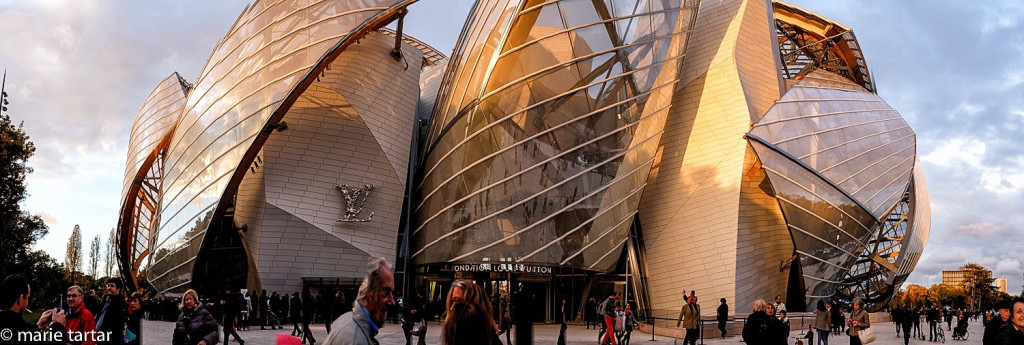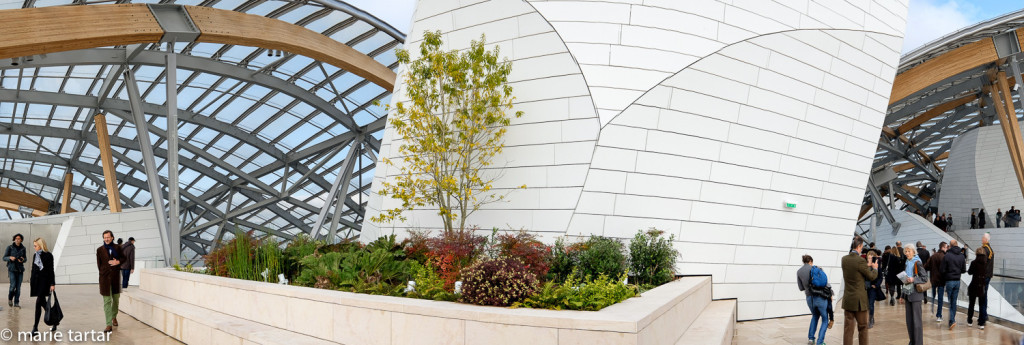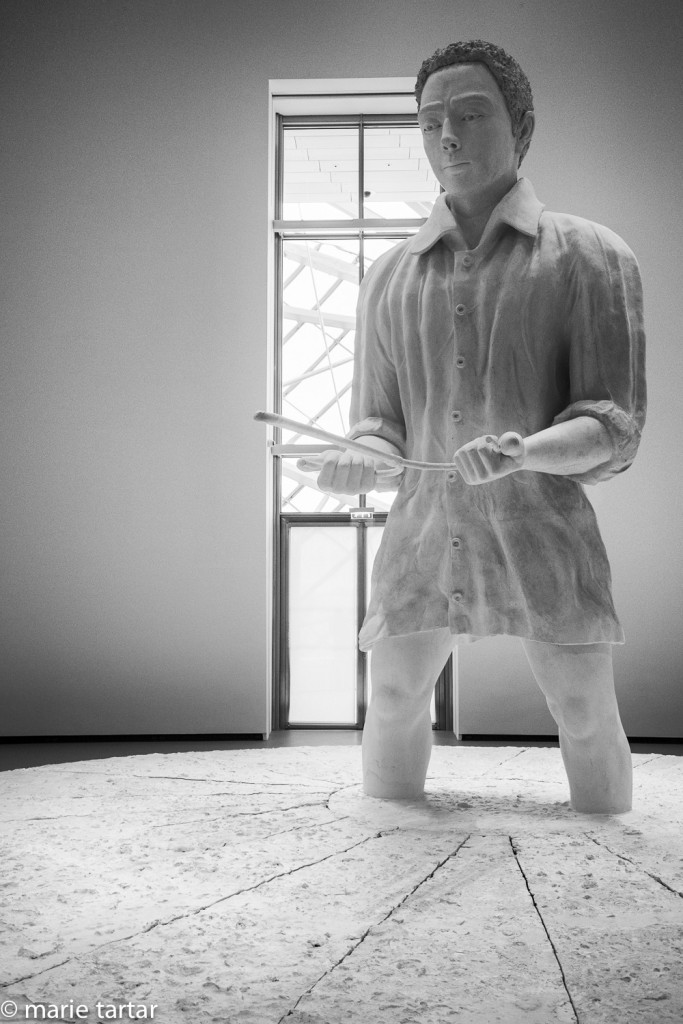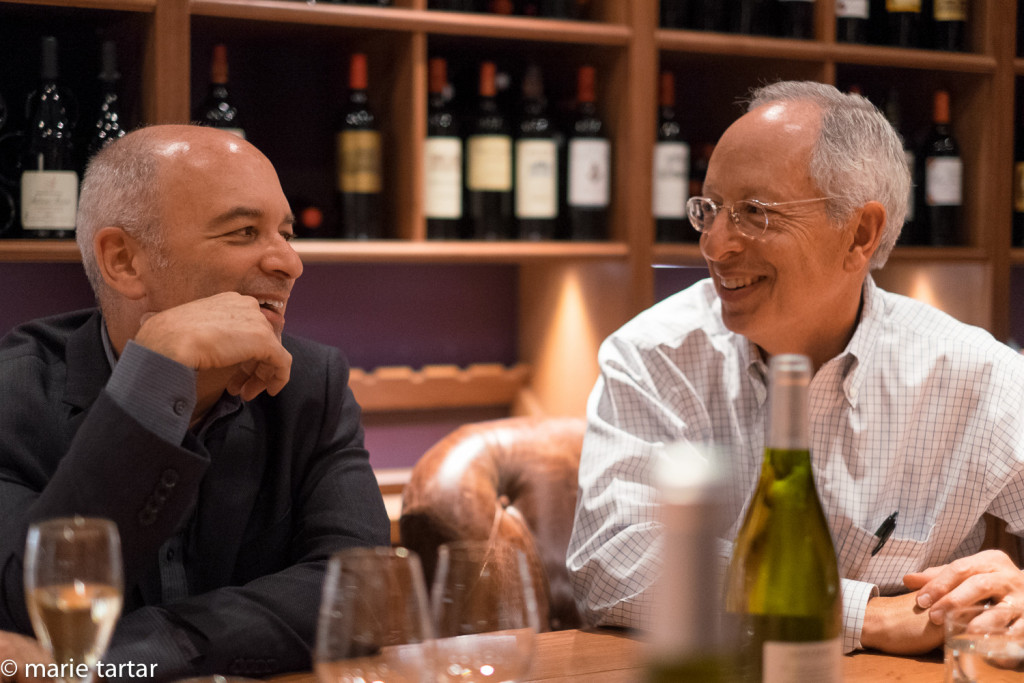
Tuesday, Nov 11, 2014
After a wonderful week’s stay in London, exploring first by ourselves and then a round of artist studio visits with MOPA, it was on to the second half of our MOPA trip, and in some ways, the main attraction, Paris Photo.
Traveling on Armistice Day (our Veterans Day) had implications, with some museums closed. Even on the Eurostar train, the traditional 2 minutes of silence was observed at 11 am, recalling the end of WW I on the 11th hour of the 11th day of the 11th month, in 1918.
Being a holiday, the line was even longer than usual and the crowds thicker as we headed to the Marais and rue des Rosiers for our traditional first meal at L’as Du Fallafel.
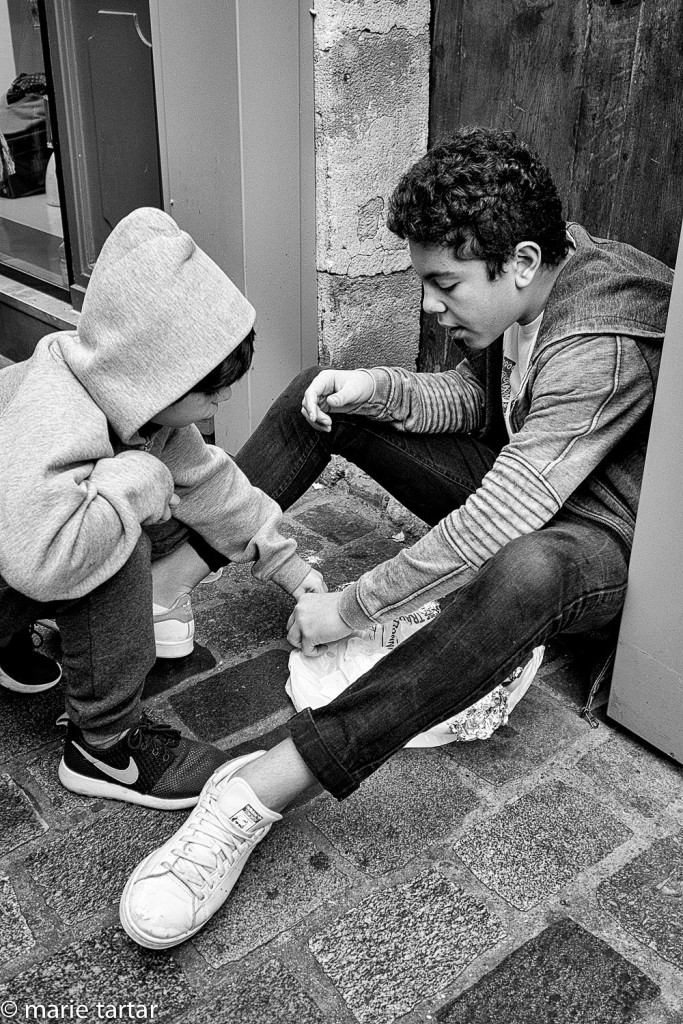
I did find a few photo subjects on rue des Rosiers while waiting for my fallafel at L’as Du Fallafel
While en route to Musée de la Chasse, which proved to be closed for the holiday, we “discovered” hidden gardens associated with the National Archives that we had never noticed. Le Musée d’art et d’histoire du Judaisme, just down the street, was also new to us. It was featuring a comprehensive show of Romain Vishniac, entitled De Berlin à New York, 1920-1975, so in we went. A few years ago (2010), I read a fascinating article in the Sunday NY Times Magazine about a scholar’s recent discoveries and fuller reappraisal of Vishniac’s work in light of this new evidence, so this was a great opportunity to gain a fuller sense of his oeurve.
Patricia met us for dinner at Le Comptoir, where we shared the house white (Sancerre) and a salad of haricots verts, foie gras and artichokes, roasted coquilles St. Jacques with carmelized endives and Steve had a savory parmentier d’effiloche de lièvre, a version of shepard’s pie with celery root puree and hare. We selected the stewed prunes with citrus and red wine for dessert, so I was delighted when it reappeared every morning at breakfast.
Wed, Nov 12, 2014
Opening of Paris Photo
Jane, a friend from San Diego and a Paris regular, had told me several benefits of staying at Relais Saint Germain. One was access to the kitchen, namely Le Comptoir, for on the nights when a gastronomic, fixed price meal is on offer, there is virtually no way to get a reservation unless you are staying there. A daily enticement-le petit dejeuner. Breakfast has never been an a strong motivator for me, but breakfast chez Le Comptoir was exceptionnel-fresh orange juice, croissants, breads, ham, cheese, stewed prunes, yogurt, an egg if desired. It was also really pleasant sitting in the window with a view to the passing world.
Before we knew it, it was time for our VIP car service (BWM 640) to the Grand Palais-deisel, très confortable et chic! (Courtesy of BWM, a sponsor of Paris Photo). It was a sunny and beautiful fall day, unusually warm for this time of year. From 11 am until we left about 4 pm, it was non-stop, and we barely made a scratch in seeing all of the vendors from all over the world.
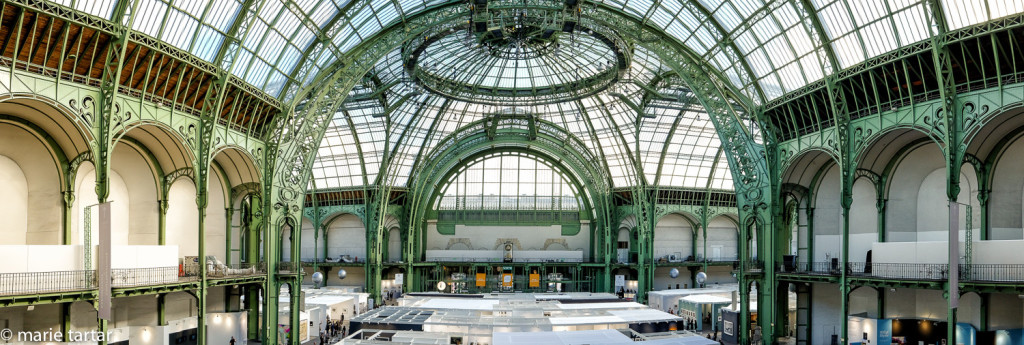
Le Grand Palais is a beautiful, light-filled space for the crush of humanity that Paris Photo becomes after the VIP opening day and the approach of the weekend
Compared to White Cube in London, most works were comparatively affordable. Our favorite piece was on offer from Frankl Gallery in San Francisco, by Hiroshi Sugimoto, a gorgeously ambiguous candle-light white slash through a black field, $100 thousand dollars. More affordable and still tempting were small square prints offered with a gorgeous graphic black and white early series by William Klein, $2000 for the book including a selection of 1 of 6 prints.
We made a break toward 4 pm to head to Musée de la Chasse et de la Nature to meet up with Milène Guermont, a Parisian artist friend, who had 2 works on display there, one a sound piece (Escampette, 2014) and the other a video piece (Barre, 2014), in conjunction with a show of works of the equestrian studio of pere et fils Delton, active in Paris 1862-1914. The show, entitled Voilà Les Delton, featured their specialized form of portraiture, namely la Belle Epoque societé, with their horses. The museum was a real surprise and delight, wonderfully eccentric.
The museum’s name had always put me off, but it really is a mélange of artwork, artifacts and furniture related to animals, not really a celebration of hunting per se. We especially loved the mix of contemporary and traditional. It was a wonderful introduction to the work of a contemporary English sculptress, Kate MccGwire, who utilizes feathers as her medium, concocting anthropomophoid forms and sensuous shapes and rivulets which emerge unexpectedly in beautiful flows and ambiguous figures.
We headed back west via metro afterwards for a short return to Paris Photo, and from there walked further east to the Musée d’Art Modern de la Ville de Paris for a reception for the Prix Pictet. There was abundant wine and some cheese, but not much too eat and no place to sit, so I was ready to go by the time the theme of the next cycle was announced: disorder.
Home on the RER to Notre Dame Saint-Michel and to a quick standing room only dinner at L’Avant Comptoir next door, a lively and convivial joint. We shared a few plates, including piments verts (grilled green Spanish peppers), carpaccio de boeuf, sardines (heated in their tin), bread, all finger-licking good. Only L’Avant Comptoir could induce me to stand a bit more after standing all day.
Thursday was devoted to studio visits in morning and afternoon and a multi-course gourmet blow-out dinner with wine pairing at Verjus.
First stop was just down the street at the home and studio of Marc Riboud, a photojournalist and Magnum photographer.
His wife Catherine was there, a lovely older woman with gorgeous white hair and gracious profile. He is over 90 years old and wasn’t up to seeing us.
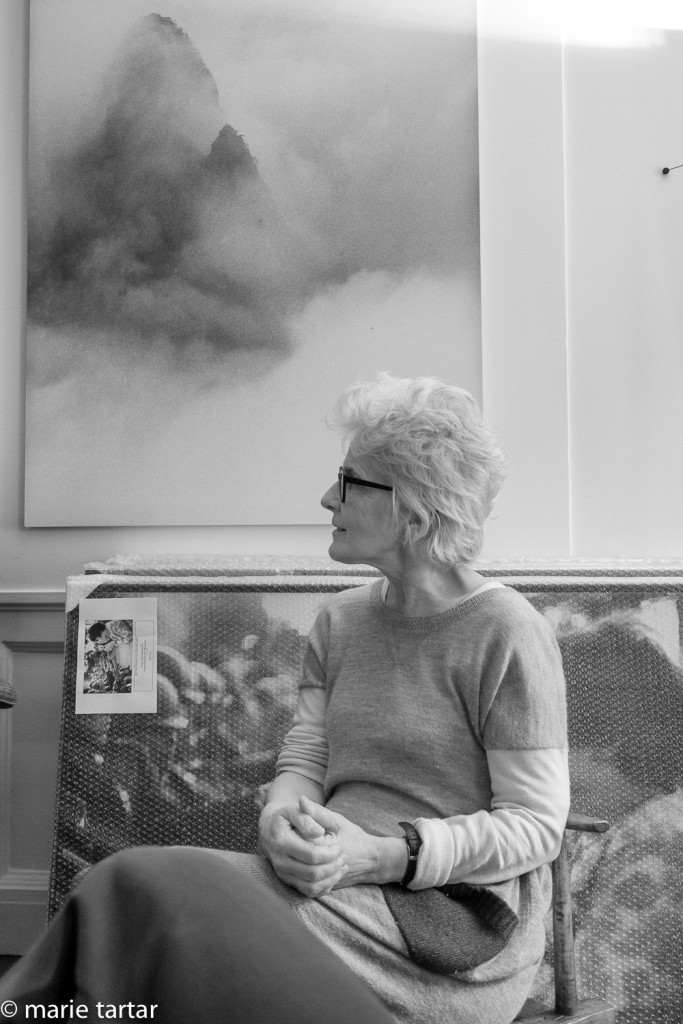
Study in silver and greys: Elegant Catherine Chaine, wife of Magnum photographer Marc Riboud and our hostess for our studio visit, is also co-author of charming children’s books using Marc’s images as illustrations, like I comme Image
For lunch, I asked for a recommendation from the hotel. We were steered to Brasserie Vagenende, one of the oldest brasseries in Paris. Dating from 1904, it is splendidly ornate, mirrored and beautifully preserved. Our waiter was a delight, so personable. Everything was delicious, from the pumpkin soup (poured over a bowl studded with chestnuts, with a centerpiece of Roquefort), to leeks with a vinaigrette sauce to Deborah’s and Christina’s plate of rillettes and pates.
In the afternoon, we headed southeast to the 13th arrondissement, to the shared studio of Japanese photographic artists Yuki Onodera and Aki Lumi. Yuki and Aki live in an interesting complex of government subsidized, dedicated live-work studios for artists-what a progressive governmental concept! Deborah knew and liked an early body of Yuki’s work in which she had photographed disembodied discarded clothes against cloudy skies (Portrait of Second-hand Clothes). Not traditional portraiture, but definitely evocative, and almost an alternate form of archetyping. This work dates from a seminal year for Yuki, 1993, the year of the move to Paris and the year of an exhibit by Christian Boltanski in Paris called Dispersion, in which heaps of old clothes stood in for massacre victims. The public was allowed to cart away a sack full for 10 francs, with which Yuki launched her artistic career in Paris.
She has an amazing diversity of other bodies of work, all incorporating photography, but in generally subservient roles to her artwork (as Aki explained about one body of work incorporating portions of swishing birds wings, again against a cloud-filled sky: “NOT nature photography.”) I especially liked a series called Look Out the Window of tiny luminous houses isolated against a looming blackness. Aki’s work is lush and layered, and also quite varied. His large scale, photographic Garden works are richly colored and dense with innumerable layers, while earlier, more spare “Tracery” line drawings seem to be the foundation on which later painted and drawn and even more mysterious “Fracto-graph” works are based.
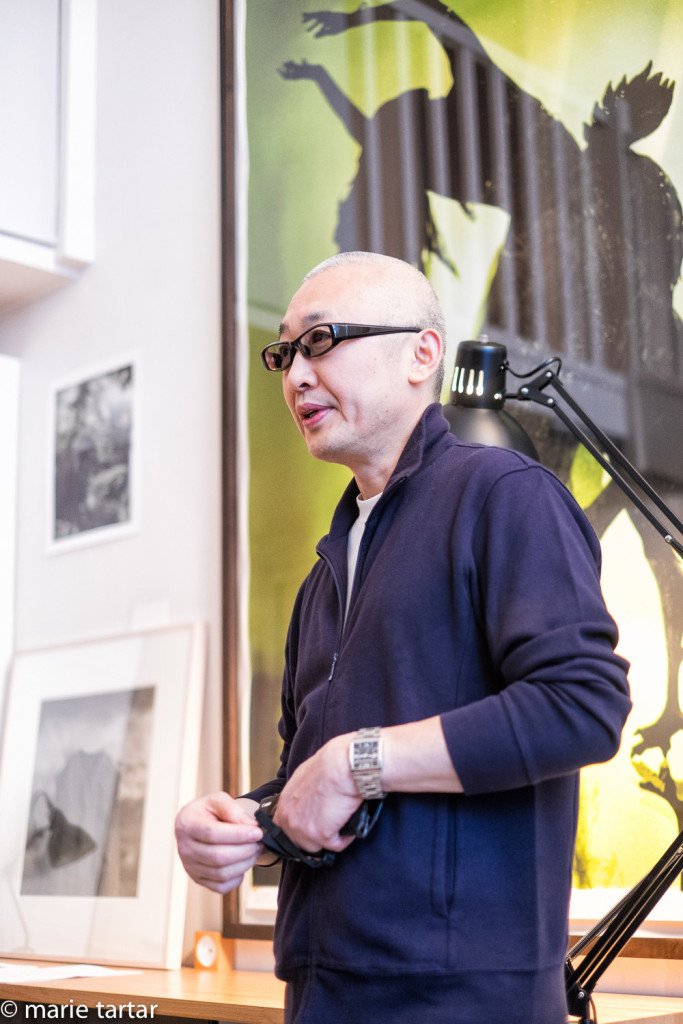
Aki Lumi in the Paris studio he and Yuki share; in the background, one of Yuki’s Annular Eclipse works can be glimpsed
After giving Christina a subway ticket, Steve and I found ourselves unable to get ourselves easily home by subway as planned. We went into the station, intending to restock, to buy a carnet (packet of 10 tickets). We tried the Visa card, no go, probably because the card had no chip. Not to worry, we have American Express, which does have a chip.
Woops, they don’t take American Express.
Okay, we’ll pay with cash. Woops, we have two 50 Euro notes, and only enough coins to buy one subway ticket. The machine doesn’t accept bills larger than 20 Euros.
Not to worry, we’ll get change. No, they won’t change the bill at the information window.
Having had to exit the station in search of change, we eventually decide, we’ll walk.
We do stop at an ATM on the way home, and request mostly 10 and 20 Euro notes.
The dinner at Verjus was a series of gastronomic home runs by Braden and l’equipe. The 3rd floor private dining room seats 10 perfectly, including MOPA stalwart Valerie Stallings and photographic artist Flor Garduño, who we visited in Mexico City the prior year. We thoroughly enjoyed all 6 courses (68 E tasting menu, optional 45 E wine pairing), from the celery root and wood sorrel napoleon starter to the salted lemon cake finish, with squid, monkfish, duck breast and wild boar confit stops in between! Steve and I have been enjoying Braden’s cooking and Laura’s wine pairings since their days hosting “The Hidden Kitchen” in their apartment.
Friday brought rain, steady, drizzly, not very cold or windy.

Christina paused just long enough in the courtyard of the magnificent hotel particulier occupied by Galerie Perrotin to enable this shot
Our day started at Galerie Parrotin, which has blue chip artists like Maurizio Cattelan, here represented by a mop propping up a wrinkled white canvas. Featured artists during our visit included Korean artist Seo-Bo Park, with a series of beautiful textural, highly rigorous, large canvases, and very interesting work with simulated twisted rubber tires made of metal and elaborately carved real rubber tires and intricately filigreed silver covered suitcases by Wim Delvoye.
Our ostensible reason for going to this gallery was to see work by Sophie Calle, the conceptual artist, who sheds light on the universal through the personal, mining her own life for material.
We led the group over to Place des Voges and Gerard Mulot and walked in the rain to La Maison Rouge, intending to take in the outsider art show there, as well as lunch at Rose Bakery. The lunch took most of our available time, so we only had a little flavor of the show through the dining area decoration, changed with each exhibition. The lunch was scrummy, pumpkin soup with pistachio seeds and a scrim of pesto, a wonderful lentil salad with shitakes and zucchini, and a lardon festooned quiche.
We thought we were leaving in plenty of time for a 3 pm rendezvous at Paris Photo with English artist Susan Derges, a friend, neighbor and artistic contemporary of Garry Fabian Miller, who we saw in Manaton in Southwest England. Transit was interrupted on the line, forcing us out at Chatelet and onto another line, requiring an unplanned walk from Madeleine. The VIP line into the Grand Palais was jammed. We were late, but so was everyone else, including Susan. We did manage to eventually convene in the VIP lounge, even scrounging up enough chairs to form a conversational group, taking over a much coveted table from Chicago gallerist Catherine Edelman.
Susan told us a fascinating story of how she visited Garry in Manaton, met someone there, prompting her to move there, only to later learn her grandfather’s side of the family were originally from there (he had been abandoned as a baby and his family history was unknown until recovered in Manaton).
Afterwards, Larry showed us works he was considering purchasing (Alison Rossitor at Yossi Milo and Garry Fabian Miller at Hackle Bury), while we agonized about whether to buy 1, 2,3 or 4 of a possible 6 small prints of William Klein available through a limited edition book.
Larry took off, having decided to not rush a decision, as did we. We walked back by way of Palais Royale and Gallerie Vivienne, where I had spied a pair of red short boots with my name on them in a favorite Italian shoe store the prior night when they were closed.
We barely made it back to Eun Hwa before 7 pm, when I thought they were closing. The prior night, walking back from Yuki and Aki’s, we had passed their atelier and store on rue Monsieur le Prince, just down the street from the hotel. I had found a hat, with attached scarf, that I liked and bought, but forgot about doing the detax paperwork until the transaction was finished and didn’t have my passport with me. They had suggested I stop in their other branch, close to the hotel, closer to the Seine, which I had, just before closing the night before. On that occasion, a young blonde was just closing up and I didn’t think at first she was even going to open the door to let me plead my case. But as it turned out, she did, but couldn’t help me as the printer had just run out of ink…or something. En tout cas, could I come back the next day?
This time, there was a blonde mother and daughter completing transactions in the store when I entered. As my paperwork was being finished, I found a brilliant blue wool unstructured lightweight coat I liked and after being shown multiple possible variations in how to wear it by a charming Asian woman who proved to be the designer, I decided to buy it as well. The transaction finished, I stood expectantly, chatting with the designer and her sales staff, waiting to be handed the bag with my purchase in it.
Eventually, I ventured: “Mon sac?” (as in: where is it?)
The salesgirl gestured at the counter: “It was right there.”
Instantly, everyone knew what had happened. The mother and daughter blondes had finished a pair of transactions just before mine, and had undoubtedly scooped up mon sac with theirs.
The owner stepped in, not to worry, and flew down the street to their nearby hotel (which they had mentioned while in the store). Explaining the situation to the desk clerk there, armed with the mother’s name, yielded no blondes or sacs. Not to worry, she took down my hotel information, and reassured me she would deliver it to my hotel personally after returning to the store for the daughter’s information and locating it. Which is presumably just what happened, as about 15 minutes after returning to the hotel, there she was in the hotel’s lobby, avec mon sac. Case of the missing sac solved!
Dinner was a wonderful gourmand affair chez Le Comptoir and a reunion with Cindy and Gerry, back from cycling in Greece and now staying in their Paris Marais apartment they were so generous to loan to us in January. The 5 course meal is a good value at 60 Euro, given this is Paris and excellent contemporary haute cuisine, but I notice there is an alternative offering for each course (except dessert) which is available for a supplement ranging from 15-30 Euros. For example, one could have had Homard bleu jus boudin ananas for 30 E more, instead of the Morue de St. Jean de Luz, seiche, chorizo et cebettes bouillon a l’encre de seiche. This could add up quickly if one selected all of the alternatives; the night we ate there, that would have been 85 E on top of the base of 60 E! We didn’t have any problem enjoying all 5 courses of the set menu!

Gastronomic dinner with great friends, Cindy and Gerry, at Le Comptoir, doesn’t get much better than this!
Sat, Nov 15, 2014
Last day in Paris, always a delightful dilemma, how to spend a currency so precious?
The newly opened Frank Gehry designed Fondation Louis Vuitton beckoned from the Bois du Boulogne on the western margins of Paris. Between taking in a Frank Gehry retrospective at the Pompidou and seeing a Frank Gehry building in person, especially one which has attracted so much recent press-no contest. Patricia arranged 12 noon entry tickets for us on line, so we met up beforehand at Les Sablons metro stop on Line 1. The trees in the forest were outfitted in their autumn hues, making the short walk to the museum even more pleasant.
The museum itself is overwhelming, and gasp-inducing. Ten years in the making, it is the product of the world-wide taste for luxury goods, a private venture financed by LVMH chairman Bernard Arnault.
We spent the whole afternoon slowly exploring it, inside and out.
The afternoon was a glorious crisp but mild fall day, with clearing storm clouds to enliven the sky. The surrounding park has a variety of attractions aimed at children (an adorable dragon “my first rollercoaster,” ponds with ducks on which one can pilot a canot, even a short zipline).
The blue sky, golden leaves and animated clouds in the afternoon light were wonderful photographic foils for the building’s beguiling translucency and soaring scale.
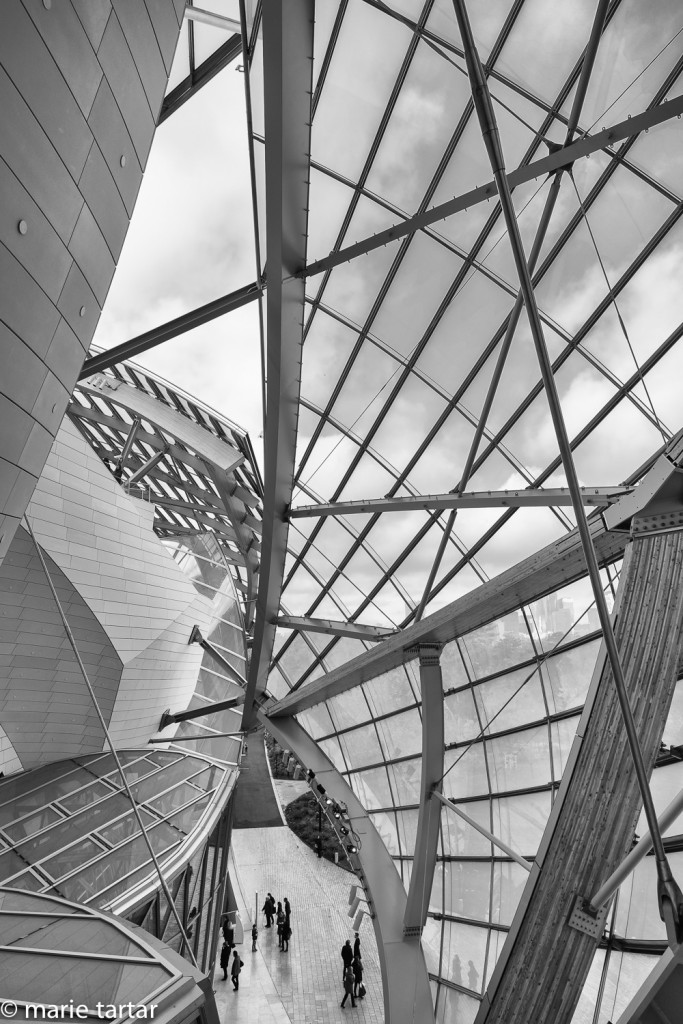
Gehry’s “double building”: soaring scale and wonderfully ambiguous delineation of inside from outside.
At some level it seemed a gigantic jungle gym for adults, criss-crossed by staircases and terraces at multiple levels.
There is a large mirrored and yellow-glassed visually fascinating installation by Icelandic/Danish artist Olafur Eliasson, whose design for the façade of the Harpa concert hall we had so enjoyed in Reykjavik. It has a definite funhouse aspect to it, with shadows and reflections playing along a reflecting pool, both inside and out.
We started our exploration by being led on a walking “tour” called One Hundred Forty-Six Steps, by a pair of interesting artists, Janet Cardiff and George Bures Miller. We had loved her sound installation “40 Part Motet” in the Cloisters in NYC the preceding year. For this, we were issued Ipods, which led us from gallery to gallery, with the video screen activated by dance, musical and art performances which had been staged in the previously empty galleries.
The galleries themselves were enormous, one devoted to Gerhard Richter, rounding out a triumvirate of major contemporary German artist shows this trip. A huge metal Isa Genzken rose sculpture bloomed in the entry, extending from one floor to another.
Huge fish mobiles, with panels of translucent scales, animated the ceiling of the dining room, Le Frank. We picnicked outside on delicious chez Patricia chicken sandwiches on the circular benches in the garden, admiring the view of the newest contemporary architectural goliath from the lawn.
It was a delightful afternoon, a wonderful convergence of art, architecture, nature, and the new.
Our evening send-off was a wine tasting dinner at Ô Chateau in the 1st arrondissement. This had been our idea, based on really enjoying and learning beaucoup at 2 wine tasting sessions on our prior trip in January. We knew they would do a good job with the wine and had the perfect size, wine-lined private room, but had never eaten there. Our instructor was Daniel, who we remembered from before, both extraordinarily knowledgeable and highly entertaining, skillfully distilling history into a very palatable and logical progression.
By this time, we had dwindled to an intimate group of 6, with Cliff, John, and Deborah besides me and Steve. We were joined for the evening by photographic artist David Miesel, whose work we admire. He has been included in prior MOPA shows, and it was pleasure to be able to get better acquainted with him. Gary and Larry were already winging their way home, and Christina was recovering from a bout of food poisoning, possibly due to a malevolent shellfish lurking in a heaping seafood platter a few nights before.
Appropriately enough, the evening began with champagne. While enjoying Monmarthe “Secret de Famille” champagne, Daniel filled us in on what makes champagne so unique. For starters, the Champagne region, east of Paris, is the northernmost winegrowing region in Europe. The area is characterized by poor soil as well as a cool climate. Per Daniel, good champagne derives from bad dry wine with no residual sugar as a starting point.
Our first course was a smooth and savory soup of potiron, a pumpkin-colored squash, accompanied by Chenin Blanc.
The main course, beef, was served with a 2010 Grand Cru Bordeaux from Saint Emilion (“Aux Plantes”). Steve and I remember Saint Emilion fondly from the Backroads bike trip on which we met Cindy and Gerry. Deborah gave it a valiant try, but wasn’t seduced by its hints of chocolate and berries.
Dessert was a cream puff, not my favorite type of dessert, but one of the best examples I’ve had. Daniel had selected a noble rot sweetened wine for us, which cut right through the cream of the filling.
Sunday, November 16, 2014
Just as I was thinking departure day couldn’t have gone smoother, we had the bad fortune to encounter a super-stickler inspectress at Heathrow security screening. From our packed and ready to go presentation at 7 am for a last sumptuous Relais Saint Germaine petit dejeuner, to our trip by metro to Chatelet, transfer to an express RER to CDG, all had gone like clockwork. We even landed early in Heathrow.
Our extra time was swiftly chewed up by innocent omissions on our part, an extra-sensitive liquid detector at Heathrow, and a punitive security official.
While I had segregated our liquid toiletries into a Ziploc and submitted it for screening as usual, I have NEVER included the tiny quantities of lotion and eye drops I carry in my purse. Nor have I ever pulled out (or been asked to do so), the small bottle of lens cleaner I keep in the camera bag. This time through, it seemed the liquid sensor was amped up and hyper-sensitive and flagged the bags as needing minute examination. It probably didn’t help that Steve forgot to take the laptop out of the camera backpack (in his defense, I usually wear it).
The lady charged with sorting us out swabbed each and every lens, flash, charger and other camera paraphernalia in the camera backpack with excruciating thoroughness, leading to a backup in the line of other scofflaws behind me (Steve having taking safe refuge at a distance). The unfortunates behind me were audibly beginning to wonder how long it would be before she got to them when she finally, finally released me to completely repack the camera backpack.
So, lesson learned, at least for Heathrow: all liquids, even the lens cleaner, will henceforth go into the little baggie with the other gels and liquids.
Our several hour layover thoroughly chewed up, there was just time for an expedited snack at Wagayama noodle bar, making it to our boarding area with 10 whole minutes to spare!
So many words and images in only 5 days in Paris! That’s Paris for you, an embarrassment of riches, the proverbial moveable feast. Some of my favorite images, Paris at night, will have to await a future, axilliary separate post. So, stay tuned, au revoir!
-Marie
Brasserie Vagenende
142, blvd St-Germaine, 75006
01 43 26 68 18
www.vagenende.com




